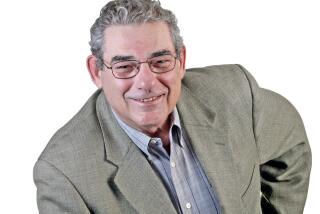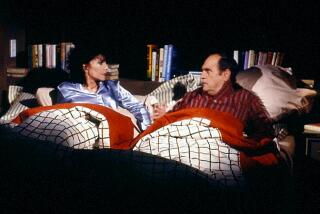THE MAKING OF McPAPER: The Inside Story of USA Today <i> by Peter Prichard (Andrews, McMeel & Parker: $19.95; 414 pp., illustrated) </i>
- Share via
When USA Today began publishing in September, 1982, the wizards of Wall Street and Madison Avenue were virtually unanimous in their hoots of derision and predictions of failure. Editors of other newspapers were equally dismissive. There was just no way, everyone agreed, that a new newspaper--starting from scratch, distributed nationally, relying almost exclusively on newsstand sales, filled with the same stories in Boston as in Bellflower--could possibly succeed in the United States today. After all, in the preceding 12 years, 141 American daily newspapers had either folded or merged. If such venerable institutions as the Washington Star, Philadelphia Bulletin and Chicago Daily News couldn’t make it, how could an upstart like USA Today survive?
But it’s always been a grievous error to underestimate either Allen Neuharth or the appetite of the American public for trivia, superficiality and self-deception. USA Today, Neuharth’s brainchild, will never be confused with The New York Times; USA Today is called “McPaper” because its format of very short stories (news McNuggets) amid a blizzard of color pictures, charts and graphs make it seem like fast-food journalism. The paper will be five years old next month, though, and it already has the second-highest circulation--and the highest readership--of any daily newspaper in the United States. After sustaining pre-tax operating losses of $486 million through 1986--plus $208 million in capital costs largely attributable to the paper--USA Today showed its first monthly profit ($1,093,756) in May; with both circulation and advertising continuing to climb, it seems clear that author Peter Prichard’s claim that the paper is “going to make it” is no idle boast.
How did it happen?
Simple. Surveys show that many people feel guilty about not reading a daily newspaper, so Neuharth made it easy for them to assuage their guilt; he created USA Today, so people could buy it and persuade themselves they were reading a newspaper. Neuharth realized that people were increasingly getting their news from television, so he created a newspaper that is more like a morning television news show than a traditional newspaper--bright, visual, nothing to severely tax the intellect; he even sells the paper in coin boxes that resemble television sets.
In addition, Neuharth listened to all those readers who complain about negative news; he decreed that USA Today would practice a “new journalism of hope.” Thus, the classic USA Today headline over a story on a plane crash: “Miracle: 327 survive, 55 die.” Finally, Neuharth is sensitive to the mounting public skepticism of and, sometimes, hostility toward the press; thus, headlines and stories in USA Today feature the word “We” or “Us,” a not-so-subliminal attempt to link readers and USA Today as “us” (as opposed to “them”--presumably the rest of the press, other Cassandras and anyone else not unquestionably devoted to the American Way--or as USA Today would have it, The USA Way). One day in 1984, the front page of USA Today featured a headline that said “We take on record hike in our debt,” a graph showing that “We’ve been watching less TV coverage of the Democratic and Republican conventions since 1952,” one story that began “We’re buying fewer personal computers than makers thought we would . . .” and another that began “Domestic jetliners flew more of us last year than ever before. . . .”
Critics ridiculed these gimmicks, but Neuharth always said his newspapers were published for readers, not for other editors, and it turns out that he knew exactly what he was doing. Readers love USA Today. They have from the beginning. It was the advertisers who were most skeptical, and once the paper proved it had enough readers--the right kind of high-demographic readers--advertisers began climbing aboard. Even some respected newspaper editors have begun to praise USA Today--for its pioneering use of color, its tight editing, its weather page, its sports statistics and its use of charts and graphs to help tell a story. Many papers have paid USA Today the ultimate compliment--they’ve copied it.
Prichard’s account of this surprising success story is as fascinating as it is unusual--unusual because Prichard has been a USA Today employee virtually from the beginning, and he has been with USA Today’s parent company, Gannett, for almost 15 years. His book is, as its subtitle says, the “inside story” on USA Today. But unlike most authorized corporate biographies, it is neither a whitewash nor an exercise in self-justification and image-polishing. For this, the reader must thank not only Prichard (the managing editor for cover stories at USA Today) but Neuharth, the man who conceived of both USA Today and this book (a book, not surprisingly, that resembles USA Today in its physical appearance--16 pages of color and 140 other pages (out of 357 total) with illustration of one sort or another, be it photograph, chart, map or some other graphic device).
Neuharth, who grew up poor in a small South Dakota town, became a newspaper reporter and editor before joining Gannett as general manager of the chain’s hometown papers, in Rochester, N.Y., in 1963. By the time he began preliminary planning for USA Today in 1979, he was chairman, president and chief executive officer of Gannett.
Before USA Today, Gannett was the publisher of 88 daily newspapers in 36 states, with a combined circulation of 3.6 million--more than The New York Times, Los Angeles Times, Washington Post and Chicago Tribune combined. The chain was enormously successful financially, with annual revenues of more than $1 billion and profits so consistently high that even Neuharth joked that the correct way to pronounce Gannett was “with the emphasis on the ‘NET.’ ”
But Gannett was the Rodney Dangerfield of American newspaper publishers; it got no respect. Virtually all of Gannett’s papers were in small and medium-size towns, and the company was widely perceived as looking on its newspapers as cash registers, not as a public trust. Prichard concedes, in one of the book’s few self-serving euphemisms, that Gannett “lacked a national reputation for journalistic excellence” (which is a little like saying that “Gary Hart lacked a reputation for marital fidelity”).
Neuharth thought a new, national daily newspaper could both improve Gannett’s national reputation and--ultimately--be profitable as well, and he cajoled, manipulated, flattered and challenged his board of directors and top executives into making that happen.
Starting with a four-man planning group, Neuharth personally supervised virtually every detail of the paper’s conception and execution in a manner unprecedented for the chief executive of a major media company.
“For the first year of publication,” Prichard writes, “Neuharth personally laid out USA Today every day, deciding how many pages it would have, how much news, how much advertising and which ads would run where.”
Neuharth also wrote and rewrote many stories and headlines and flooded his subordinates with memos on every aspect of the paper.
Not everyone at Gannett was convinced that Neuharth knew what he was doing. Neuharth is smart, tough, a shrewd operator, a hustler; a friend of his once told me, “When Al wears a sharkskin suit, it’s hard to tell where the shark stops and where he begins.” But Neuharth is also a cocky risk-taker; another Neuharth friend--and longtime top aide--once told me, “He’s the sort of man who would go after Moby Dick with a rowboat, a harpoon and a jar of tartar sauce.”
Many people inside and outside Gannett saw USA Today as little more than a mammoth ego trip for Neuharth, a last-ditch bid to join the Arthur Sulzbergers and Katharine Grahams at the pinnacle of the publishing world. Some top Gannett executives--Neuharth dubbed them “the enemies within”--even resisted Neuharth’s USA Today sales pitch and fought against the start-up and continued financing of the paper, convinced that it would damage and perhaps even destroy Gannett. This was particularly true of Douglas H. McCorkindale, Gannett’s chief financial and legal officer, and Prichard not only provides details of his opposition but suggests that this opposition may have cost McCorkindale a chance to succeed Neuharth. (When Neuharth named his successor as president and chief executive officer last year, he chose John J. Curley, the first editor of USA Today. Neuharth, 63, remains Gannett’s chairman.)
Prichard is not reluctant to point out some of Neuharth’s mistakes and personal shortcomings--buying the wrong computer system, telling his top aides early on to ignore the potential for home and mail delivery of USA Today, having someone else tell the paper’s top circulation official that he was being replaced--and the portrait he paints of Neuharth, while admiring, is not without blemishes, a few of them quite ugly.
Prichard had access to all of Neuharth’s confidential files and memos, in addition to the files of most other Gannett and USA Today executives, and his account of their struggles, squabbles and exhausting work load in the USA Today launch makes for intriguing and sometimes amusing (or, on occasion, appalling) reading. In November, 1984, for example, Neuharth was worried about the paper’s continued loss of money--$339,726 a day at that point--and he thought he had to “do something dramatic” to shake some of his top aides out of their lethargy, “to get people’s attention . . . to turn the thing around.”
First, he summoned members of the paper’s management committee to a Sunday meeting at his house in Florida. There he gave them a blunt speech and announced a 5% cut in the payroll. Then he invited everyone to dinner at a nearby restaurant.
When they walked in, they found the restaurant arranged to resemble the scene of the Last Supper, with Neuharth, wearing a crown of thorns, standing in front of a large wooden cross.
“I am the crucified one,” he told them, launching into what Prichard calls a “mixed religious metaphor,” combining elements of the Last Supper with the Jewish celebration of Passover. (If USA Today didn’t make it, Neuharth reasoned, they would all be “passed over.”)
Some of Neuharth’s guests understood his attempt to shock them; others were offended.
But Neuharth got his message across. Somehow, as this book makes abundantly clear, Neuharth always gets his message across.
More to Read
Sign up for Essential California
The most important California stories and recommendations in your inbox every morning.
You may occasionally receive promotional content from the Los Angeles Times.










